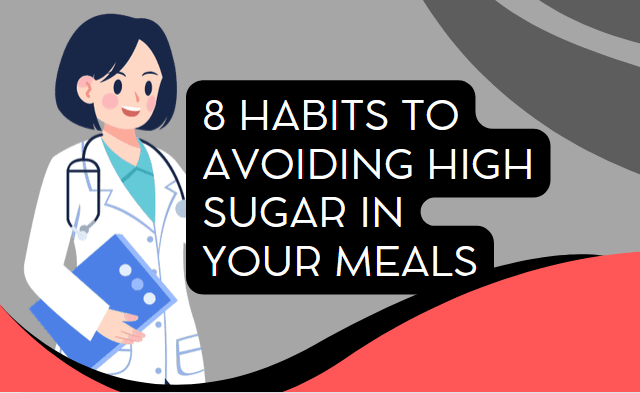Over the years, I’ve developed some solid habits to prevent my blood sugars from spiking after meals. Today, I’ll share eight of these habits with you. In this well detailed and comprehensive article, I will be exploring 8 habits/tips for avoiding high sugar in meals.
Regardless of your type of diabetes or even if you don’t have a diagnosis, you’ve probably heard about the importance of managing blood sugars post-meal. This can be tricky because balancing food and blood sugars is challenging.
For a non-diabetic, normal blood sugar levels range from 70 to 100 mg/dl. People with diabetes aren’t expected to maintain these levels 24/7, but the goal is to manage them as best as possible.
According to the CDC, blood sugars should be less than 180 mg/dl two hours after the start of a meal (10 mmol/l for those using the metric system). Personally, I aim for levels below 140, ideally closer to 100, two hours post-meal. Here’s how I achieve that.
1. Choose Low Glycemic Index Foods
The first on our list of 8 habits or tips for avoiding high sugar in meals is making the choice of low glycemic index (GI) foods; this will help manage blood sugar levels effectively.
The GI measures how fast a food raises blood sugars, while the glycemic load (GL) measures how much it raises them. Foods are categorized into three GI groups: low (1-55), medium (56-69), and high (70+).
Studies show that low GI foods can improve blood sugar levels and lower A1C. For example, Ezekiel bread, a sprouted whole grain bread, has a low GI of 35 and a low GL of 9 for two slices or one muffin.
2. Practice Portion Control
Portion control is crucial. It’s not just about what you eat, but also how much. Sometimes, reducing the portion size is enough to manage blood sugar spikes. I love good food, and date nights often involve delicious meals.
To avoid overeating, I plate my food in the kitchen rather than bringing the whole tray to the table. Using smaller plates and limiting to one serving helps. When dining out, I often ask for half the meal to be packed up for later.
3. Incorporate Fiber-Rich Foods
Fiber-rich foods are beneficial for managing blood sugars. Fiber can slow digestion, reducing post-meal spikes. There are two types of dietary fiber: soluble and insoluble. Soluble fiber dissolves in water, forming a gel-like substance in the stomach, which helps reduce blood sugar spikes. This is third on our list of 8 habits or tips for avoiding high sugar in meals.
Insoluble fiber passes through the digestive system without being broken down. Aim for 22 to 34 grams of fiber daily by choosing whole grains, non-starchy vegetables, beans, legumes, and lentils.
4. Focus on Balanced Meals
Balanced meals, including protein and fat along with carbohydrates, can slow glucose absorption and reduce blood sugar spikes. Protein sources like chicken, eggs, fish, and meat can make you feel fuller and help with weight management.
Adding healthy fats, such as those from vegetable oils, fish, nuts, and seeds, can also slow glucose digestion.
5. Stay Active
Exercise is extremely effective for blood sugar management. Regular activity improves insulin sensitivity, helping clear glucose from the bloodstream more efficiently.
Even two minutes of activity after a meal can have an impact, but I recommend aiming for at least 10 minutes. Any activity that raises your heart rate, like dancing, gardening, or seated exercises, can help.
6. Limit Sugary and Processed Foods
The 6th on our list of 8 habits or tips for avoiding high sugar in meals is reduction of sugary and processed foods. Reducing sugary and processed foods can significantly impact blood sugar management.
Instead of completely eliminating these foods, consider reducing portions or choosing healthier alternatives. For example, swap a sugary cereal for a low-carb option or eat only a small portion of a muffin.
7. Understand Food and Its Impact
Understanding how different foods affect your blood sugars is crucial. Everyone’s body reacts differently to foods. Experiment by tracking what you eat, the quantities, and how it affects your blood sugars.
Using tools like MyFitnessPal can help you understand the nutritional content of your meals.
8. Measure Blood Sugars Often and at the Right Times
The last but not the least on our list of 8 habits or tips for avoiding high sugar in meals is ensuring that you measure your blood sugar regularly. Frequent and timely blood sugar measurements are essential. I use a Continuous Glucose Monitor (CGM) that sends readings to my phone 24/7.
If you don’t have a CGM, using a glucometer to measure blood sugars before and two hours after meals can provide valuable insights. Aim for blood sugars below 180 mg/dl two hours post-meal, but closer to 100 is ideal. This habit has been my most powerful tool for reducing post-meal blood sugar spikes.
Conclusion
I hope these 8 habits or tips for avoiding high sugar in meals will help you manage your blood sugars more effectively. If you have any habits that work for you, I’d love to hear about them in the comments. Blood sugar spikes after meals are just one part of diabetes management. Find time to also read these 10 unusual ways to lower blood sugar level as revealed by Dr. Ahmedan.






